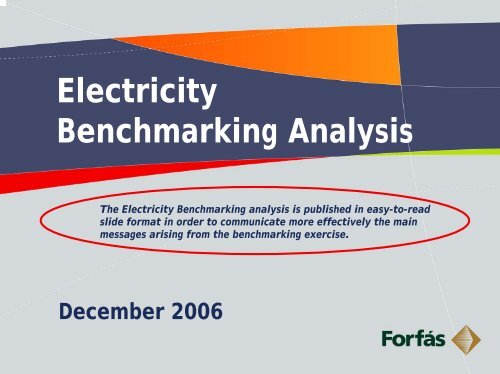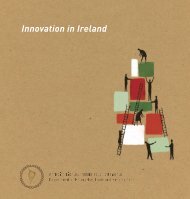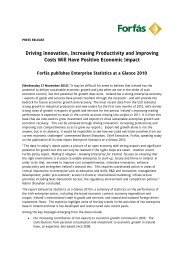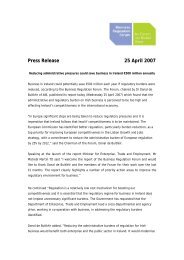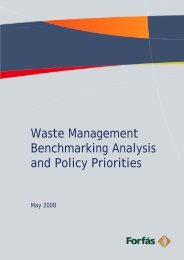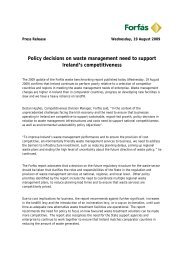Electricity Benchmarking Analysis Report (web only) - Forfás
Electricity Benchmarking Analysis Report (web only) - Forfás
Electricity Benchmarking Analysis Report (web only) - Forfás
Create successful ePaper yourself
Turn your PDF publications into a flip-book with our unique Google optimized e-Paper software.
<strong>Electricity</strong><br />
<strong>Benchmarking</strong> <strong>Analysis</strong><br />
The <strong>Electricity</strong> <strong>Benchmarking</strong> analysis is published in easy-to-read<br />
slide format in order to communicate more effectively the main<br />
messages arising from the benchmarking exercise.<br />
December 2006
2<br />
Table of Contents<br />
► Introduction<br />
► Key Findings<br />
► Energy and Industry<br />
► Overview of the Irish <strong>Electricity</strong> Market<br />
► Key Performance Indicators<br />
► References
3<br />
INTRODUCTION
4<br />
<strong>Electricity</strong> & Enterprise Development<br />
► A reliable, secure and competitively priced<br />
electricity supply is a vital ingredient in the<br />
competitiveness of Irish industry and Ireland’s long<br />
term economic development.<br />
► Ireland’s ability to continue attracting high levels of<br />
foreign direct investment and to provide a<br />
supportive environment for enterprise generally will<br />
depend on its capacity to deliver a secure and<br />
uninterrupted energy supply at a competitive cost.
5<br />
Indicators<br />
In consultation with <strong>Forfás</strong> and the <strong>Electricity</strong> <strong>Benchmarking</strong> Steering*<br />
Group, Pöyry (formerly ILEX) developed a series of indicators to provide a<br />
backdrop against which to complete a more detailed analysis of Ireland’s<br />
comparative electricity performance.<br />
Price of<br />
electricity<br />
Retail prices<br />
– to domestic and<br />
industrial<br />
customers<br />
– with and without<br />
taxes<br />
– snapshot and<br />
trend<br />
Wholesale<br />
prices<br />
– price levels<br />
– presence or<br />
absence of<br />
wholesale price<br />
indicators<br />
Security of<br />
supply<br />
Primary fuel<br />
import %<br />
Fuel mix of<br />
generation<br />
Plant margin<br />
Largest set size<br />
Size of market<br />
Barriers to entry<br />
in generation<br />
Hours<br />
interruption<br />
Service access<br />
and quality<br />
Degree of<br />
unbundling<br />
– transmission<br />
– distribution<br />
Regulated third<br />
party access<br />
– transmission<br />
– distribution<br />
Network density<br />
– transmission<br />
– distribution<br />
Number of<br />
suppliers<br />
Competitive<br />
landscape<br />
Market<br />
concentration<br />
– retail<br />
– wholesale<br />
Market opening<br />
Switching rates<br />
% foreign<br />
ownership<br />
Note: *The <strong>Electricity</strong> <strong>Benchmarking</strong> Steering Group included representatives from industry as well as the Department of<br />
Communications, Marine and Natural Resources, the Department of Enterprise, Trade and Employment, the Commission for<br />
Energy Regulation (CER), Enterprise Ireland, IDA Ireland and the Western Development Commission.
6<br />
KEY FINDINGS
7<br />
Increasing Demand<br />
Key Findings (1)<br />
<strong>Electricity</strong> demand in Ireland continues to grow. Annual growth in 2005<br />
was 3.1% compared with an annual increase of 1.1% in the EU-25.<br />
Average annual growth of about 4% is forecast in the medium term in<br />
Ireland.<br />
Higher Prices<br />
The price increases of recent years have put Ireland at a competitive<br />
disadvantage in relation to the EU-15 average. Up until 2001, industrial<br />
electricity prices in Ireland were below the EU-15 average but since<br />
then they have been significantly higher.<br />
Ireland recorded the second highest increase in industrial electricity<br />
prices of the EU-15 countries during the period 2000-2006.<br />
Industrial electricity prices (excl. VAT but incl. Other Taxes) rose by<br />
52.7% in Ireland over the six-year period, compared to the more<br />
modest increase of 28.9% in the EU-15.
8<br />
Security of Supply<br />
Key Findings (2)<br />
Ireland has a low level of spare electricity capacity over and above peak<br />
demand compared to the other benchmark countries.<br />
It is expected that there will be sufficient generation capacity to meet<br />
demand until 2010 unless plant closure is advanced, or the availability<br />
performance of existing plant deteriorates, in which case supply shortages<br />
could arise in winter 2007 and winter 2008. To ensure generation<br />
adequacy in the short to medium term, it is critical that the performance<br />
of existing plant is improved and stabilised.<br />
• Ireland is the second most reliant of the 13 benchmark countries on fossil<br />
fuels for electricity generation with 93% of its fuel mix made up of fossil<br />
fuels.<br />
Limited Competition<br />
Both the generation and retail supply markets are relatively more<br />
concentrated in Ireland than in the other benchmark countries.<br />
France, followed by Ireland and Portugal have the least competition within<br />
their retail supply markets as a single large company with a very high<br />
market share dominates each and their generation market is dominated by<br />
a large generator.
9<br />
Ireland’s Overall Performance<br />
Key Findings (3)<br />
Ireland (along with Italy and Singapore) is joint bottom of<br />
the 13 benchmark countries on the composite indicator of<br />
meeting industry electricity needs. Ireland failed to secure<br />
a score higher than 5 on any of the four broad areas of<br />
focus, namely prices, security of supply, access/quality and<br />
competitive landscape.<br />
Ireland’s lowest ranking was on price where it scored 2 and<br />
it also scored poorly (score of 4) on the important security<br />
of supply indicator.
10<br />
ENERGY & INDUSTRY
11<br />
Index of GDP, Total Primary Energy<br />
Requirement and Energy CO 2 , 1990-2004<br />
Source: SEI<br />
► The Irish energy market is one of the fastest growing in the developed world<br />
with the Total Primary Energy Requirement (TPER) growing by 59.3% between<br />
1990 and 2004.<br />
► Changes in the structure of the economy and improvements in energy<br />
efficiency have resulted in the relative decoupling of TPER from economic<br />
growth.
12<br />
Historic Forecast<br />
Energy Demand by Sector<br />
Historic vs. Future<br />
Services<br />
Transport<br />
Manufacturing<br />
Note: Mtoe = Millions of tonnes of oil equivalent (conventional standardised unit of energy) . Industry is defined as<br />
manufacturing industry.<br />
Source: SEI<br />
► Sustainable Energy Ireland (SEI), using the macro-economic assumptions<br />
underpinning the high growth scenario of the ESRI’s Medium-Term Review:<br />
2005-2012, forecast energy demand growth of 43.6% percent in the<br />
period, 2005 to 2020 compared to the 64% increase in the previous 15<br />
years.
13<br />
<strong>Electricity</strong> Demand by Sector<br />
Services<br />
Residential<br />
Manufacturing<br />
1990-2004<br />
Note: Mtoe = Millions of tonnes of oil equivalent (conventional standardised unit of energy) . Industry is defined as<br />
manufacturing industry.<br />
► In terms of electricity demand, there has been strong growth in the<br />
services sector in the last decade.<br />
Source: SEI<br />
► Manufacturing industry’s electricity demand increased during the 1990s<br />
but has fallen back in recent years due to greater energy efficiencies and<br />
structural changes in the sector (e.g. closures of Irish Ispat (steel) and Irish<br />
Fertilizer Industries).
14<br />
<strong>Electricity</strong> Demand – Growth and Shares<br />
1990-2004<br />
Growth<br />
% Average Annual Growth Rates % Share %<br />
1990-<br />
2004<br />
1990-<br />
2004<br />
1990-<br />
1995<br />
1995-<br />
2000<br />
2000-<br />
2004 2004 1990 2004<br />
Industry 49.1 2.9 4.9 6.0 -3.2 -5.4 38.5 29.9<br />
Transport 760.0 16.6 0.6 5.3 59.5 547.2 0.1 0.7<br />
Residential 77.6 4.2 3.7 5.0 3.8 5.4 34.5 31.9<br />
Services 188.6 7.9 5.2 8.9 10.1 -1.2 23.3 35.0<br />
Agriculture 42.7 2.6 3.2 2.7 1.6 0.6 3.6 2.6<br />
Total 96.1 4.9 4.5 6.3 3.8 2.1<br />
Source: SEI<br />
► Manufacturing industry’s share of electricity demand declined from 38.5% in<br />
1990 to 29.9% in 2004 while services saw its share increase from 23.3% to<br />
35%, making it the largest sector in terms of electricity demand.
15<br />
29.9%<br />
13.1%<br />
8.2%<br />
13.3% 17.8%<br />
4.7%<br />
4.3%<br />
7.4%<br />
Industry's Energy Demand by Sector<br />
Ireland vs. EU-15<br />
IRELAND EU-15<br />
1999 2004 1999<br />
6.2%<br />
2004<br />
20.7%<br />
20.4%<br />
24.2% 24.2%<br />
5.3%<br />
0.2%<br />
Misc<br />
Eng and metal<br />
Pulp, paper, print<br />
Food, drink, tobacco<br />
Non met. mineral<br />
products<br />
Chemical industry<br />
Non-ferrous metals<br />
Iron & Steel<br />
5.3%<br />
26.7%<br />
6.5%<br />
2.4%<br />
47.5%<br />
5.0%<br />
20.3%<br />
9.5%<br />
2.1%<br />
55.0%<br />
2.2%<br />
Source: Eurostat<br />
► Manufacturing industry’s energy demand by sector in Ireland differs<br />
considerably from that of the EU-15. In 2004, the largest energy consumers in<br />
Ireland were the Food, Drink & Tobacco sector followed by the Engineering &<br />
Metals and Chemical sectors.
16<br />
100%<br />
80%<br />
60%<br />
40%<br />
20%<br />
0%<br />
Biopharm<br />
Biotech R&D<br />
Business<br />
Hotel<br />
Cost Profile for a Typical Firm<br />
by Sector, 2006<br />
Engineering<br />
Labour Property Transport Telecommunications Energy Water & Waste Other Costs<br />
Financial<br />
Services<br />
Food<br />
Processing<br />
Medical Tech<br />
Telecom<br />
Software<br />
Source: National Competitiveness Council<br />
► Recent research by the National Competitiveness Council (NCC) provides a<br />
breakdown of the costs profile for a selected firm across eight sectors. Caution<br />
should be exercised when drawing sectoral inferences as the profiles are<br />
based on a selected firm in each sector.<br />
► Energy expenditure as a share of total costs is largest for the selected Food<br />
Processing firm.
17<br />
100%<br />
80%<br />
60%<br />
40%<br />
20%<br />
0%<br />
Biopharm<br />
Biotech R&D<br />
Cost Profile (excl. Labour Costs)<br />
for a Typical Firm by Sector, 2006<br />
Business<br />
Hotel<br />
Engineering<br />
Financial<br />
Services<br />
Food<br />
Processing<br />
Property Transport Telecommunications Energy Water & Waste Other Costs<br />
Medical Tech<br />
Telecom<br />
Software<br />
Source: National Competitiveness Council<br />
► When labour costs are excluded, energy expenditure as a share of total<br />
costs is still largest for the Food firm. It is also a significant cost for the<br />
Biopharma, Business Hotels, Engineering and Medical Technology firms.
18<br />
OVERVIEW OF IRISH<br />
ELECTRICITY MARKET
19<br />
Generation<br />
Transmission<br />
Ownership<br />
Transmission<br />
Operation<br />
Distribution<br />
Supply<br />
ESB<br />
IE<br />
ESB<br />
CS<br />
<strong>Electricity</strong> Market Structure<br />
ESB Generation Viridian Synergen Edenderry<br />
Energia<br />
(Viridian)<br />
ESB Networks<br />
Eirgrid<br />
ESB Networks<br />
Airtricity<br />
Note: Size of block is not intended to represent market share.<br />
Tynagh Aughinish<br />
Bord<br />
Gáis<br />
CH<br />
Power<br />
Distributed<br />
Generators
20<br />
Year<br />
<strong>Electricity</strong> Demand Growth<br />
Total <strong>Electricity</strong><br />
Requirement (GWh)<br />
% Annual Growth<br />
2001 23,511 -<br />
2002 23,912 1.7%<br />
2003 24,673 3.2%<br />
2004 25,581 3.7%<br />
2005 26,371 3.1%<br />
Source: CER<br />
► Total <strong>Electricity</strong> Requirement (TER) in Ireland recorded substantial<br />
growth in recent years, increasing by 12.2% during the period 2001-<br />
2005.<br />
► The annual growth in 2005 was 3.1% compared with an annual<br />
increase of 1.1% in the EU-25 and 0.3% in the UK.
21<br />
<strong>Electricity</strong> Demand Forecasts<br />
Source: Eirgrid<br />
► Eirgrid’s Generation Adequacy <strong>Report</strong> 2007-2013 looks at three possible<br />
demand scenarios – high (assumes increase of 4.2% p.a.), median (increase<br />
of 3.9% p.a.) and low (increase of 2.4% p.a).<br />
► The forecast high and median demand growth scenarios are very much in<br />
line with historical trends while the low growth scenario represents a<br />
relative slow down.
22<br />
Per Capita Demand<br />
Source: Eirgrid<br />
► <strong>Electricity</strong> demand per capita in Ireland has been increasing at a<br />
faster rate than in the rest of the EU in recent years, as evidenced by<br />
the narrowing gap between Ireland and the EU-15 and EU-25 above.<br />
► Per capita demand in Ireland is forecast to surpass that of the EU-25<br />
in the next couple of years.
23<br />
Energy Policy Developments<br />
► Energy Green Paper<br />
In October, DCMNR published the Green Paper which puts forward energy<br />
policy options for the next decade and beyond to ensure safe and secure<br />
energy supplies, promote a sustainable energy future, and deliver<br />
competitive prices to Irish consumers. The Energy White Paper is due to<br />
be published in early 2007.<br />
► Single <strong>Electricity</strong> Market (SEM)<br />
Since publication of the All-Island Energy Market Development Framework<br />
in 2004, significant progress has been made towards implementation of<br />
the SEM. The aim of SEM is to provide competitive, sustainable and<br />
reliable markets in electricity and natural gas on the island of Ireland at<br />
the minimum cost necessary. SEM is due to go live in November 2007.<br />
► Market Structure<br />
The CER recently announced that ESB will close or divest 1,300 MW of<br />
existing power plant by 2010. This represents almost 30% of ESB’s<br />
present generation capacity. The CER will oversee the ensure that the<br />
appropriate mid-merit plants to reduce ESB’s market power are closed by<br />
2010.
24<br />
KEY PERFORMANCE<br />
INDICATORS
25<br />
Euro/100 kWh<br />
10<br />
8<br />
6<br />
4<br />
Industrial <strong>Electricity</strong> Price Trends<br />
1996-2006<br />
1996 1997 1998 1999 2000 2001 2002 2003 2004 2005 2006<br />
EU-15 Ireland UK<br />
Excl. VAT but incl. Other Taxes<br />
Source: Eurostat<br />
Note: Industrial electricity prices are based on annual consumption of 2,000 MWh; maximum demand of 500 kW<br />
and annual load of 4,000 hours.<br />
► The price increases of recent years have put Ireland at a competitive<br />
disadvantage in relation to the EU-15 average. Up until 2001, industrial<br />
electricity prices in Ireland were below the EU-15 average but since then<br />
they have been significantly higher.<br />
► While there had been a significant gap between industrial electricity prices<br />
in Ireland and the UK in recent years, increases in wholesale prices in the<br />
UK have seen that gap narrow in 2006.
26<br />
Percentage Increase<br />
70<br />
60<br />
50<br />
40<br />
30<br />
20<br />
10<br />
0<br />
58.1<br />
Sweden<br />
52.7<br />
Ireland<br />
44.5<br />
Germany<br />
40.3<br />
Denmark<br />
Increase in Industrial <strong>Electricity</strong> Prices<br />
1 Jan 2000 to 1 Jan 2006<br />
37.7<br />
Netherlands<br />
34.1 32.0<br />
Finland<br />
Belgium<br />
28.9 28.0 27.1<br />
EU 15<br />
Italy<br />
Portugal<br />
26.2<br />
Luxembourg<br />
Excl. VAT but incl. Other Taxes<br />
23.8<br />
UK<br />
17.0<br />
Greece<br />
13.3<br />
Spain<br />
1.9<br />
France<br />
Source: Eurostat<br />
Notes: 1. This price comparison relates to prices as of 1 st January but price increases are applied at different times across<br />
the benchmark countries, therefore the data should be interpreted accordingly.<br />
2. Data for Austria was not available.<br />
► Ireland recorded the second highest increase in industrial electricity prices of<br />
the EU-15 countries during the period 2000-2006.<br />
► Industrial electricity prices (excl. VAT but incl. Other Taxes) rose by 52.7% in<br />
Ireland over the six-year period, compared to the more modest increase of<br />
28.9% in the EU-15.
27<br />
Euro/100 kWh<br />
14<br />
12<br />
10<br />
8<br />
6<br />
4<br />
2<br />
0<br />
Italy<br />
Cyprus<br />
Denmark<br />
Belgium<br />
Germany<br />
Ireland<br />
Netherlands<br />
Ireland<br />
Austria<br />
EU 15<br />
EU 25<br />
UK<br />
Luxembourg<br />
Slovakia<br />
Industrial <strong>Electricity</strong> Prices<br />
1 January 2006<br />
Hungary<br />
Spain<br />
Czech Republic<br />
Portugal<br />
Slovenia<br />
Malta<br />
Greece<br />
Poland<br />
France<br />
Finland<br />
Estonia<br />
Sweden<br />
Other taxes<br />
VAT<br />
Excl. Taxes<br />
Lithuania<br />
Latvia<br />
Source: Eurostat<br />
Note: This price comparison relates to prices as of 1 st January but price increases are applied at different times across the<br />
benchmark countries, therefore the data should be interpreted accordingly.<br />
► VAT and Other Taxes (energy taxes, green taxes, local taxes etc) vary<br />
considerably across the EU-25. Ireland ranked 6 th of the EU-25 when all taxes<br />
are included.
28<br />
Euro/100 kWh<br />
Euro/100 kWh<br />
14<br />
12<br />
10<br />
14<br />
12<br />
10<br />
8<br />
6<br />
4<br />
2<br />
0<br />
8<br />
6<br />
4<br />
2<br />
0<br />
Italy<br />
Italy<br />
Cyprus<br />
Cyprus<br />
Ireland<br />
Denmark<br />
Germany<br />
Belgium<br />
2005 2006<br />
2005 2006<br />
Belgium<br />
Germany<br />
Netherlands<br />
Ireland<br />
Ireland<br />
Netherlands<br />
Luxembourg<br />
Ireland<br />
Austria<br />
EU 15<br />
EU 15<br />
EU 25<br />
EU 25<br />
Austria<br />
UK<br />
UK<br />
Luxembourg<br />
Portugal<br />
Slovakia<br />
Denmark<br />
Industrial <strong>Electricity</strong> Prices<br />
Hungary<br />
Slovakia<br />
Spain<br />
Hungary<br />
1 Jan 2005 vs. 1 Jan 2006<br />
Czech Republic<br />
Spain<br />
Portugal<br />
Czech Republic<br />
Slovenia<br />
Malta<br />
Poland<br />
Greece<br />
Malta<br />
Slovenia<br />
Greece<br />
Poland<br />
France<br />
Sweden<br />
Finland<br />
France<br />
Estonia<br />
Incl. All Taxes<br />
Excl. VAT but incl. Other Taxes<br />
Finland<br />
Sweden<br />
Estonia<br />
Lithuania<br />
Lithuania<br />
Latvia<br />
Source: Eurostat<br />
Latvia<br />
Source: Eurostat<br />
► There has been a slight improvement in Ireland’s comparative performance in the<br />
year to 1 January 2006 as other countries experienced larger increases.<br />
► In 2006, Ireland ranks 6 th (4 th highest in 2005) of the EU-25 when all taxes are<br />
included and 3 rd (2 nd highest in 2005) when VAT is excluded but Other Taxes are<br />
included.
29<br />
Euro/MWh<br />
70<br />
60<br />
50<br />
40<br />
30<br />
20<br />
10<br />
0<br />
Italy<br />
Ireland<br />
Ireland<br />
Spain<br />
Singapore<br />
Netherlands<br />
Wholesale <strong>Electricity</strong> Prices<br />
UK<br />
Germany<br />
France<br />
NZ<br />
Denmark<br />
2004<br />
2005<br />
Finland<br />
Source: Pöyry<br />
Notes: 1. The wholesale price for Ireland is based on the Best New Entrant Price (BNE) and for other countries on<br />
the average annual wholesale electricity price using published data.<br />
2. Data not available for Portugal and US.<br />
► Many of the benchmark countries experienced large increases in wholesale<br />
prices year on year and as a result the gap between Ireland and the other<br />
countries has narrowed significantly. Ireland remains among the most<br />
expensive of the benchmark countries in terms of wholesale prices.<br />
► The fact that other markets experienced increases in their wholesale prices<br />
later than Ireland could be caused by a range of factors from the fuel mix<br />
and associated costs to the local regulatory regime.
30<br />
100%<br />
90%<br />
80%<br />
70%<br />
60%<br />
50%<br />
40%<br />
30%<br />
20%<br />
10%<br />
0%<br />
Finland<br />
Portugal<br />
(10) (10)<br />
Coal Oil Gas<br />
Nuclear Comb. Renew. & Waste Geothermal<br />
Solar, Tide, Wind Hydro Other<br />
Spain<br />
Italy<br />
(10) (9)<br />
Denmark<br />
Germany<br />
(8) (8)<br />
UK<br />
US<br />
(8) (8)<br />
Ireland<br />
Fuel Mix, 2004<br />
Netherlands<br />
NZ<br />
Singapore<br />
France<br />
Source: Pöyry<br />
Notes:1. Numbers in brackets represent each country’s score (out of 10) for the diversity of the fuel mix used in generation.<br />
2. Data for Singapore is for 2003.<br />
► While Ireland scored 7 out of 10 for the diversity of the fuel mix used in<br />
electricity generation, most of the benchmark countries scored 8 or above. This<br />
puts Ireland in the bottom five in terms of the diversity of its fuel mix.<br />
► France has the least diverse portfolio as reflected in its low score (1).<br />
(7)<br />
(6)<br />
(5)<br />
(4)<br />
(1)
31<br />
100%<br />
90%<br />
80%<br />
70%<br />
60%<br />
50%<br />
40%<br />
30%<br />
20%<br />
10%<br />
0%<br />
Singapore<br />
Ireland<br />
Netherlands<br />
Italy<br />
UK<br />
Denmark<br />
Reliance on Fossil Fuels, 2004<br />
Fossil Fuels Nuclear Comb. Renew. & Waste Geothermal Solar, Tide, Wind Hydro Other<br />
Note: Data for Singapore is for 2003.<br />
► When the fossil fuels (gas, oil and coal) are combined, Ireland is the second<br />
most reliant of the 13 benchmark countries on fossil fuels for electricity<br />
generation. 93% of Ireland’s fuel for generation comes from fossil fuels.<br />
Portugal<br />
US<br />
Germany<br />
Spain<br />
Finland<br />
NZ<br />
France<br />
Source: Pöyry
32<br />
European Fuel Mix and Indicative<br />
Costs – An Explanation<br />
► The next slide sets out a high level comparison of the<br />
impact of the fuel mix on generation costs. It suggests<br />
that the fuel mix plays a significant role in the relative<br />
level of final end-user prices across European countries.<br />
► According to the Green Paper, the fuel mix used in<br />
generation in Ireland accounts for over 70% of the<br />
differential between Irish and European generation<br />
costs.
33<br />
Marginal cost of<br />
generation<br />
European Fuel Mix and Indicative<br />
Weighted Average Generation Costs<br />
Gas Hydro Nuclear Coal Oil Weighted average<br />
generation cost<br />
€27/MWh €4/MWh €7/MWh €21/MWh €38/MWh<br />
Generation fuel Mix (%)<br />
Country<br />
rankings<br />
Austria 17% 68% 0% 11% 1% €10/MWh 10<br />
Belgium 35% 9% 37% 14% 3% €16/MWh 8<br />
Denmark 18% 0% 0% 50% 7% €18/MWh 6<br />
Finland 12% 18% 16% 48% 6% €17/MWh 7<br />
France 1% 22% 54% 13% 9% €11/MWh 9<br />
Germany 20% 8% 19% 44% 4% €18/MWh 6<br />
Greece 13% 26% 0% 40% 18% €20/MWh 5<br />
Ireland 49% 10% 0% 21% 17% €25/MWh 1<br />
Italy 37% 26% 0% 18% 15% €21/MWh 3<br />
Luxembourg 27% 70% 0% 0% 0% €10/MWh 10<br />
Netherlands 75% 0% 2% 20% 0% €25/MWh 1<br />
Portugal 21% 40% 0% 17% 20% €18/MWh 6<br />
Spain 15% 17% 24% 31% 8% €16/MWh 8<br />
Sweden 1% 48% 28% 3% 13% €10/MWh 10<br />
United Kingdom 33% 5% 15% 37% 7% €21/MWh 3<br />
Source: Deloitte & Touche
34<br />
Capacity margin as proportion of peak demand (%)<br />
40%<br />
20%<br />
0%<br />
41%<br />
38%<br />
22%<br />
25%<br />
Level of Spare <strong>Electricity</strong> Generation<br />
Capacity Over and Above Peak Demand<br />
7%<br />
19%<br />
13%<br />
17%<br />
16%<br />
14%<br />
9%<br />
10%<br />
Ireland<br />
Singapore NZ Spain Italy UK Germany Portugal Ireland Netherlands France<br />
Notes:1. The figure for NZ is unadjusted for availability.<br />
2. Denmark and Finland are excluded because availability information for these two countries is based on the<br />
entire Nordic region rather than country specific information. The US is also excluded.<br />
6%<br />
14%<br />
3%<br />
2004<br />
2005<br />
7%<br />
3%<br />
Source: Pöyry<br />
► This indicator is based on the ratio of spare capacity (i.e. the difference between available capacity and peak demand)<br />
to peak demand. Peak demand is at its highest in Ireland in winter but for other countries it will be in summer due to<br />
demand for electricity for air conditioning. To calculate the available capacity, installed capacity data for each country<br />
is adjusted using the ratio of available to installed capacity from the European Transmission System Operator.<br />
► Interconnection is not taken into account as peak demand often occurs at similar times in neighbouring countries. For<br />
generation adequacy assessments, the CER has agreed a reliance of 200MW on Northern Ireland can be assumed.
35<br />
Generation Adequacy<br />
► The previous slide shows that Ireland has a low level of spare<br />
electricity capacity over and above peak demand compared to the<br />
other benchmark countries. This is primarily due to the fact that<br />
installed capacity in Ireland is not greatly in excess of peak demand.<br />
► The performance of generation plant in Ireland is also low compared<br />
to other countries. While plant availability had improved to the mid<br />
80s during 2005, it has deteriorated during 2006 and in recent months<br />
has fallen below 80%. Plant availability in the UK averages 87%.<br />
► According to the recently published Generation Adequacy <strong>Report</strong> by<br />
Eirgrid, under all demand growth scenarios (see Slide 21) and assuming<br />
median plant availability, there will be sufficient generation capacity<br />
to meet demand until 2010. However, if plant closure is advanced, or<br />
the availability performance of existing plant deteriorates, then supply<br />
shortages could arise in winter 2007 and winter 2008.<br />
► To ensure generation adequacy in the short to medium term, it is<br />
critical that the performance of existing plant is improved and<br />
stabilised. Eirgrid also recommends that plant designated for closure is<br />
in an available state until replacement generation capacity has been<br />
commissioned.
36<br />
100%<br />
75%<br />
50%<br />
25%<br />
0%<br />
Portugal<br />
France<br />
Market Share of Top Three Generators, 2005<br />
Singapore<br />
Ireland<br />
Ireland<br />
NZ<br />
Spain<br />
Notes: 1. Market share indicator is based on the installed capacity of each player.<br />
2. Data not available for generator 3 in Denmark. Data for New Zealand and the US is for 2003.<br />
Netherlands<br />
Italy<br />
Denmark<br />
Germany<br />
Finland<br />
generator 3<br />
generator 2<br />
generator 1<br />
UK<br />
US<br />
Source: Pöyry<br />
► In Portugal, France and Ireland, the generation market is dominated<br />
by one large generator.
37<br />
100%<br />
75%<br />
50%<br />
25%<br />
0%<br />
Portugal<br />
Market Share of Top Three Suppliers, 2005<br />
France<br />
Spain<br />
Netherlands<br />
Ireland<br />
Ireland<br />
Singapore<br />
Italy<br />
Germany<br />
Approx % Market Share of 3rd largest<br />
Approx % Market Share of 2nd largest<br />
Approx % Market Share of 1st largest<br />
Notes: 1. Market share indicator is based on the volume of electricity supplied by each player.<br />
2. Data not available for Denmark. Data for Singapore is for 2004 and the US is for 2003.<br />
NZ<br />
UK<br />
Finland<br />
US<br />
Source: Pöyry<br />
► France, followed by Ireland and Portugal have the least competition<br />
within their retail supply markets as a single large company with a<br />
very high market share dominates each.
38<br />
Composite Indicator<br />
Composite indicator<br />
(Equal weighting) Den Fin Fra Ger Ire Ita NL NZ Por Spa UK US Sin<br />
Indicator I: price 6 9 7 3 2 2 5 7 4 5 6 5 3<br />
Indicator II: security of supply 7 6 2 7 4 5 3 5 4 8 8 8 5<br />
Indicator III: service access and quality 5 7 5 5 5 6 8 5 6 7 9 5 5<br />
Composite indicator (equal weighting) 6 7 5 5 4 4 5 6 5 7 8 6 4<br />
Indicator IV: competitive landscape 7 8 1 7 4 6 7 6 3 4 10 6 4<br />
Source: Pöyry<br />
Note: The scale used for each ranking runs from 0 to 10, where 0 refers the least attractive result from the perspective of a<br />
business customer and 10 refers to the most attractive within the group of benchmark countries.<br />
► Pöyry developed a composite indicator to provide an indication of Ireland’s<br />
comparative performance in meeting the electricity needs of industry.<br />
► Ireland (along with Italy and Singapore) is joint bottom of the 13 benchmark<br />
countries on the composite indicator, having failed to secure a score higher<br />
than 5 on any of the four broad areas of focus.<br />
► Ireland’s lowest ranking was on price where it scored 2 and it also scored poorly<br />
(score of 4) on the important security of supply indicator.<br />
► The UK tops the league table on overall performance (composite indicator) with<br />
a score of 8 – it also scores highest on the competitive landscape indicator (10).
39<br />
Composite Indicator - Conclusions<br />
► Comparing the ranking on the composite indicator<br />
(price + security of supply + access/quality) and the<br />
competitive landscape indicator, the benchmark<br />
countries fall in to two broad categories:<br />
1. In half of the benchmark countries there is no<br />
obvious correlation between performance on the<br />
composite indicator and the competitive landscape<br />
indicator; and<br />
2. For the other half, performance on the composite<br />
indicator and the competitive landscape indicator are<br />
closely aligned. Denmark, Finland, New Zealand, the<br />
UK and the US score well (6 or above) on both while<br />
Ireland and Singapore score poorly on both.
40<br />
REFERENCES
41<br />
CER, <strong>Report</strong> on Ireland’s Security of Supply, August 2006<br />
http://www.cer.ie/CERDocs/cer06187.pdf<br />
References<br />
Deloitte, Review of the <strong>Electricity</strong> Sector in Ireland, December 2005<br />
http://www.dcmnr.gov.ie/NR/rd<strong>only</strong>res/54C78A1E-4E96-4E28-A77A-3226220DF2FC/26726/Deloitte<strong>Report</strong>October2006.pdf<br />
Department of Communications, Marine and Natural Resources, Towards a<br />
Sustainable Energy Future for Ireland (Green Paper), October 2006<br />
http://www.dcmnr.gov.ie/NR/rd<strong>only</strong>res/54C78A1E-4E96-4E28-A77A-3226220DF2FC/26716/EnergyGreenPaper1October2006.pdf<br />
Eirgrid, Generation Adequacy <strong>Report</strong> 2007-2013, November 2006<br />
http://www.eirgrid.com/EirgridPortal/uploads/Publications/GAR0713_v1.8.pdf<br />
Eurostat, Energy Prices in EU-25, January 2006<br />
http://epp.eurostat.ec.europa.eu/portal/page?_pageid=1996,45323734&_dad=portal&_schema=PORTAL&screen=welcomeref&open=/H/H2<br />
/H21&language=en&product=Yearlies_new_environment_energy&root=Yearlies_new_environment_energy&scrollto=0<br />
Sustainable Energy Ireland, Energy in Ireland, 1990-2004, January 2006<br />
http://www.sei.ie/index.asp?locID=70&docID=-1
42<br />
For further information please contact:<br />
Mary Twomey<br />
Competitiveness Division<br />
<strong>Forfás</strong><br />
Wilton Park House<br />
Wilton Place<br />
Dublin 2<br />
Phone: +353 (0)1 607 3000<br />
Email: mary.twomey-at-forfas.ie<br />
Contact Details


